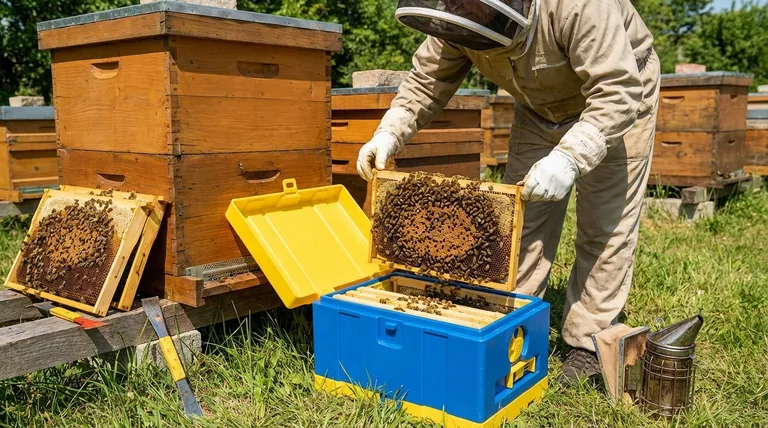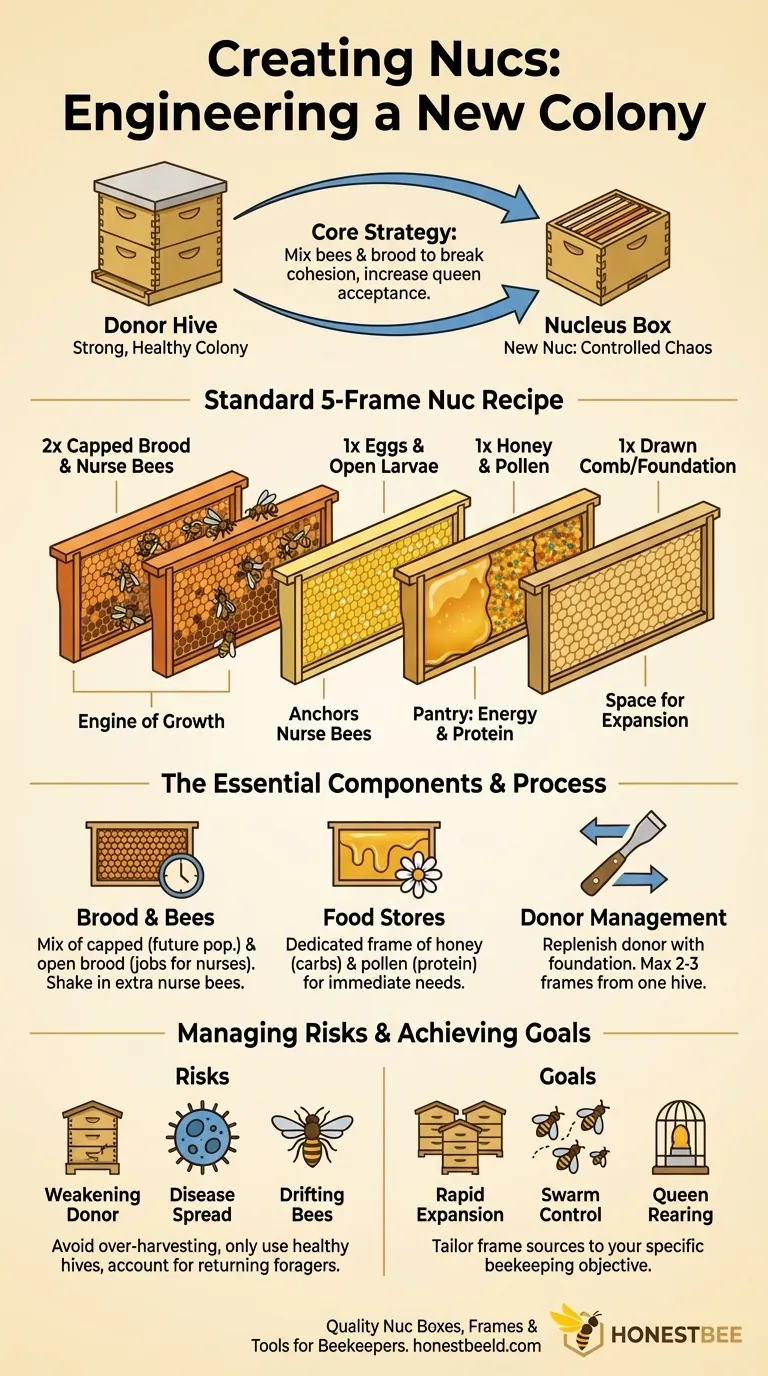The fundamental method for distributing bees and resources when creating nucs is to transfer frames from one or more strong, established hives—known as donor hives—into a new nucleus box. These frames must contain a balanced mix of brood (eggs, larvae, and pupae), food stores (honey and pollen), and the adult bees that are already clinging to them. This process intentionally creates a small, disorganized population that is primed to accept a new queen.
The core strategy is not just to move bees, but to create a state of controlled chaos. By mixing bees and brood from different sources, you break their original colony cohesion, which significantly reduces defensiveness and dramatically increases their acceptance of a new queen.

The Principle: Engineering a New Colony
Creating a nuc is an act of colony engineering. The goal is to assemble the essential components of a viable hive in a smaller box, forcing the bees to reorganize and build a new future around the queen you provide.
Why Mixing Frames Works
When bees are removed from their parent hive and mixed with bees from another, their established social structure and scent profile are shattered. They are, in effect, a collection of homeless refugees. This disorientation makes them less aggressive and desperate for the stability that a queen's pheromones provide, making them highly receptive to a new queen cell or a caged queen.
The Essential Components of a Nuc
A successful nuc is a balanced microcosm of a full-sized hive. Each frame you select serves a distinct purpose:
- Frames of Brood: This is the engine of future growth. You need a mix of capped brood, which will soon emerge to boost the population, and open brood (eggs and larvae), which gives the existing nurse bees a critical job to do.
- Frames of Food: A frame containing both honey and pollen is the pantry. Honey provides the energy (carbohydrates) for all activities, while pollen provides the protein necessary to feed the larvae and young bees.
- The Adult Bee Population: The bees clinging to the frames are the initial workforce. You must ensure there are enough nurse bees to care for the brood and enough foragers to start bringing in resources. It is common to shake in extra bees from a brood frame to compensate for older bees that will fly back to the donor hive.
Practical Distribution and Assembly
The process involves carefully selecting the right frames from the right hives to assemble a nuc with the highest chance of success.
Selecting from Donor Hives
Your donor hives must be strong, healthy, and populous. Never make nucs from weak or diseased colonies, as you will only be creating more weak colonies and potentially spreading pathogens or pests like Varroa mites throughout your apiary.
A Standard 5-Frame Nuc Recipe
A common and effective configuration for a five-frame nuc includes:
- Two frames of capped brood with their adhering nurse bees.
- One frame of eggs and open larvae, which anchors the nurse bees.
- One frame of honey and pollen to serve as the food supply.
- One frame of drawn comb or foundation to provide space for expansion.
Managing the Donor Hive
After removing frames, the donor hive must be replenished. Adding frames of foundation or undrawn comb back into the center of the brood nest gives the strong colony work to do, helps manage their growth, and can even act as a form of swarm control.
Understanding the Trade-offs and Risks
While powerful, this method is not without risks that must be managed carefully to ensure the health of both the nuc and the donor hive.
Weakening the Donor Hive
Taking too many frames of brood or bees at once can severely set back the donor hive's development. A common rule is to never take more than two or three frames of brood from a single hive at one time.
Risk of Disease Transmission
Mixing frames from multiple colonies is the most efficient way to spread disease. This underscores the critical importance of only using demonstrably healthy donor hives for making nucs.
The Problem of Drifting Bees
Many of the older, foraging-age bees will instinctively fly back to their original hive location. This is why it's crucial to include mostly young nurse bees (found on open brood frames) and to shake in extra bees to account for this loss. Moving the newly created nuc to a different apiary for a few weeks can prevent this entirely.
Applying This to Your Beekeeping Goal
The exact way you distribute resources should be tailored to your specific objective.
- If your primary focus is rapid apiary expansion: Pull one or two frames from several different strong hives to create multiple nucs without significantly impacting any single donor.
- If your primary focus is swarm control: Create a nuc by "splitting" a single, powerful hive that is preparing to swarm, using its own frames and bees.
- If your primary focus is raising new queens: Create smaller nucs with just enough resources to support a new queen through her mating flights and until she has established a solid laying pattern.
Ultimately, understanding how to properly distribute bees and resources is the key to creating strong, viable nucleus colonies for any purpose.
Summary Table:
| Resource Type | Purpose in the Nuc | Key Considerations |
|---|---|---|
| Frames of Brood | Engine of future growth; provides emerging bees and gives nurse bees a job. | Use a mix of capped and open brood. Never take more than 2-3 frames from a single donor hive. |
| Frames of Food | Pantry for energy (honey) and protein (pollen) to feed the colony. | Ensure a dedicated frame of honey and pollen is included for immediate sustenance. |
| Adult Bee Population | Initial workforce of nurse bees and foragers. | Include bees clinging to frames; shake in extra nurse bees to account for foragers that may drift back. |
| Drawn Comb/Foundation | Space for the new queen to lay and for the colony to expand. | Provides structure for the new colony to build upon immediately. |
Ready to Build Your Strongest Nucs Yet?
Creating successful nucleus colonies requires not just knowledge, but also the right, high-quality equipment. HONESTBEE supplies commercial apiaries and beekeeping equipment distributors with the durable, reliable supplies needed for efficient nuc creation and management.
We provide the tools for your success, including:
- Standard & Specialized Nuc Boxes: Durable housing for your new colonies.
- High-Quality Frames & Foundation: The essential structure for brood and food stores.
- Protective Gear & Hive Tools: Ensuring safety and efficiency during hive manipulations.
Let's grow your operation together. Contact HONESTBEE today to discuss your wholesale needs and how our equipment can support your beekeeping goals.
Visual Guide

Related Products
- 4 Frame Plastic Nuc Boxes for Beekeeping Bee Nuc Box
- HONESTBEE Professional Long Handled Hive Tool with Precision Cutting Blade
- Professional Hive Front Entrance Bee Feeder
- Boardman Entrance Bee Feeder Durable Galvanized Steel and Wood Construction for Beekeeping
- Professional Multi-Function Stainless Steel Hive Tool
People Also Ask
- How does colony growth differ between nucs and bee packages? A Guide to Faster Beehive Buildup
- How many bees are in a nucleus hive? Get a Head Start with 10,000-15,000 Bees
- What should a healthy brood nest in a nuc look like? A Guide to Strong Colony Development
- What is the recommended time of year to move bee nucs to a 10-frame hive? A Guide for Apiary Success
- What are nucleus colonies (nucs) and how do they compare to full-size Langstroth colonies?



















